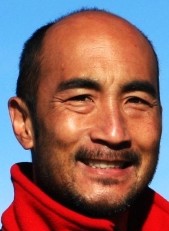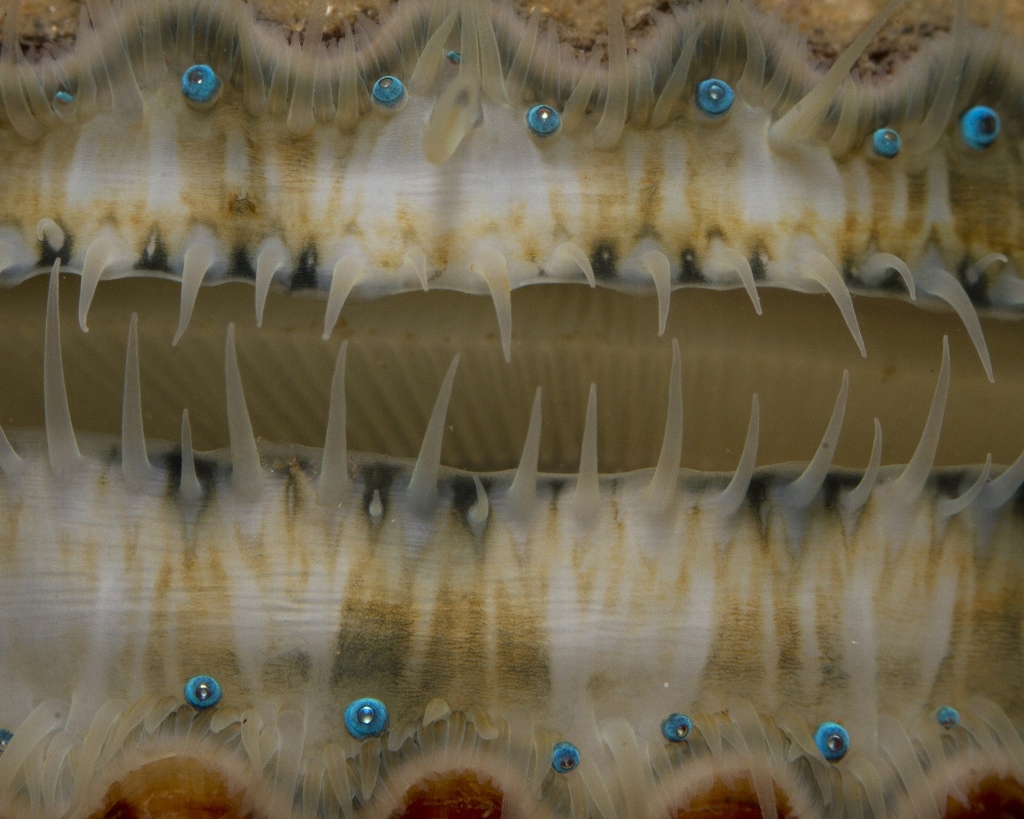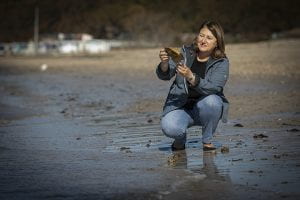Above: a close-up photo of a bay scallop (Photo by Chris Paparo).
Congratulations to the recent research grants awarded to SoMAS faculty!
Dr. Bassem Allam and co-PI Dr. Emmanuelle Pales Espinosa have received an Award from NSF in support of the project “RAPID: A matter of life or death: Identifying factors that regulate susceptibility or resistance of bay scallops to an emergent coccidian parasite” in the amount $199,996, for the period 6/15/20 – 5/31/21.
The bay scallop, Argopecten irradians irradians, is one of the most economically and ecologically important species in coastal areas of New York State and the region. In summer/fall 2019, 90% of the scallops in eastern Long Island died, and this coincided with the emergence of an undescribed parasite that disrupts the kidney of infected animals. Genetic analysis showed that the parasite belongs to the Coccidia subclass of parasites, and this pathogen is now designated bay scallop Coccidia or BSC. This project will sequence the genome of BSC. This will allow scientists to develop diagnostics to test for the presence of BSC in scallops. The project will also characterize the BSC life-cycle in scallops to understand how this parasite kills scallops. This project will also examine if environmental factors (e.g., water temperature) increases or decreases mortality rates. Results from this study will have a positive impact on the bioecomony: it will identify the biological and environmental factors that favor scallop resistance to BSC infection. This information will help scallop farmers and ecologists prevent or minimize scallop death. This research will also provide tools to enable a broad research community working on apicomplexan parasites of invertebrates. This proposal also uses funding to train a post-doc, and graduate and undergraduate students to train the next generation of STEM researchers. Overall, results expected from this work will facilitate the recovery of bay scallops in New York waters, and will serve as a reference if BSC spreads to other coastal regions in the USA.
Dr. Joe Warren has received a new award from the ONR (via subcontract with UNH) in support of the project “Acoustic and Environmental Observation Network in the NW Atlantic (AEON)”, in the amount $450,000, for the period 4/20/20 – 4/19/23.
The establishment of the Acoustic and Environmental Observation Network in the NW Atlantic (AEON) in the Gulf of Maine will complement existing oceanographic monitoring infrastructure allowing studies to be performed that may reveal significant connections between these measurements and the overall environment. The network will provide simultaneous, long-term monitoring of soundscapes and multiple acoustically relevant parameters of importance to the Navy, such as marine mammal behavior and prey concentration, at key locations where the effects of changes in the Labrador and Gulf Stream currents are projected to impact the Gulf of Maine. The proposed coordinated, interdisciplinary observation network will provide data to address the question of how acoustic parameters can be combined with large-scale and long-term oceanographic measurements to provide the most comprehensive understanding of the impact of ocean dynamics and processes on ambient sound. Specific goals of the proposed project are to: 1) establish an ocean observation network that provides acoustic monitoring and modeling of the underwater soundscape at locations across the Gulf of Maine; 2) assess the spatial and temporal behavior of the soundscape and biological scatterers, including their expected variation and correlation with distance from the observation points; 3) assess the impact of warm core rings on sound propagation and biological productivity in the Gulf of Maine; and 4) assess Gulf of Maine sound propagation impacts due to variations in upper ocean stratification and biological productivity. Results of this study will provide insights that will aid the Navy in appropriately responding to and proactively predicting how long-term environmental changes will impact operations.
Dr. Sara Hamideh has received a new Award from NSF for a RAPID, entitled “RAPID Impacts, Disruption, and Displacement after Low Attention Disasters: Experience of Non- owner and Immigrant Households” in the amount $20,000, for the period – 10/1/2019 – 5/31/2021. A brief abstract of the project is shown below.
owner and Immigrant Households” in the amount $20,000, for the period – 10/1/2019 – 5/31/2021. A brief abstract of the project is shown below.
The purpose of this research is to examine how social vulnerabilities with respect to housing tenure and immigration shape housing recovery outcomes in the aftermath of disasters that do not receive much attention and resources. The experiences of these groups in low-attention disasters has been rarely studied in the literature, particularly at household level. Also, existing insights on post-disaster experiences of renters, minorities and other vulnerable groups are often retrospective without accounting for the conditions immediately after a disaster and coping mechanisms these households use in the absence of adequate support. Expanding a pilot survey field study, the proposed qualitative case study examines life disruption, recovery resources, and displacement with a focus on non-owner and immigrant households using Marshalltown, Iowa after an EF-3 Tornado.
Dr. Hamideh has also received a new award (renewal/transfer) from NIST (via CSU) for her Center project entitled “Center for Risk-Based Community Resilience Planning.” This Center was renewed at a total of $20M, with a total to Sarah of $360,656, for the project period 2/1/20 – 1/31/25
Community Resilience Center of Excellence
Dr. Sara Hamideh is also one of the PIs on the Center for Risk-Based Community Resilience Planning that has been awarded a renewal of $20 million by U.S. Department of Commerce’s National Institute of Standards and Technology (NIST). Headquartered in Colorado State University (CSU), the Center receives $4 million annually for five years, to bring together NIST researchers and partners from 13 universities to continue developing computer and field study tools, best practices, and guidance that help local governments decide how to best invest resources intended to lessen the impact of extreme weather and other hazards on communities and to recover rapidly. Working closely in teams on more than 40 tasks, the Center of Excellence will provide a common data architecture by collaborating with the National Center for Supercomputing Applications to ensure that data from around the world can be seamlessly integrated into a robust computational environment known as IN-CORE. IN-CORE will allow users to optimize community disaster resilience planning and post-disaster recovery strategies intelligently using physics-based models of inter-dependent physical systems combined with socio-economic systems.
 Dr. John Mak has just received a new award from NOAA, for a project entitled “Quantifying the impact of biogenic and anthropogenic fluxes on the atmospheric composition of the New York City Metro Area“, for the period 9/1/20-8/31/23, in the amount $180,473.
Dr. John Mak has just received a new award from NOAA, for a project entitled “Quantifying the impact of biogenic and anthropogenic fluxes on the atmospheric composition of the New York City Metro Area“, for the period 9/1/20-8/31/23, in the amount $180,473.
Urban areas comprise only 3% of Earth’s land area, but account for ∼70% of global fossil fuel derived carbon dioxide (CO2) emissions. Many cities have pledged to adopt ambitious climate policies but our knowledge of urban scale total CO2 emissions is highly uncertain. Quantifying CO2 emissions from urban areas now will provide a baseline against which we can assess the effectiveness of policies as they are implemented. Our overarching goal is to understand the link between the CO2 and ozone (O3) cycles by improving our knowledge of the fluxes from anthropogenic and biogenic sources in urban areas. Our proposed observations in the New York Metropolitan Area (NYMA), the most populous urban center in the United States, will allow us to quantify the biogenic contribution of the CO2 and VOC budgets on daily, seasonal and interannual time scales using field observations and model estimates. We will quantify the atmospheric loading due to anthropogenic CO2 and O3 precursors over the NYMA using a range of existing inventories. Until we fully understand the role of the biosphere at mid-latitudes as a summertime carbon sink and source of reactive carbon precursors to air pollution, our confidence will remain limited in projections of the impacts of a warming climate and increased urbanization on atmospheric composition, including urban air quality and public health.
The group will couple a year-round CO2 observation network around the New York Metro Area with targeted field studies to quantify fluxes of CO2 and VOCs and improve our understanding of the processes driving spatiotemporal variability in this region. We expect the insights gained through our project will apply in some other mid-latitude urban settings. We will use a range of modeling approaches to calculate the impact of these processes on the composition and chemistry of the urban atmosphere. By advancing knowledge of both anthropogenic and biogenic carbon fluxes, we directly address the NOAA Climate goal of ‘more comprehensive knowledge of greenhouse gases’. Our proposed work directly addresses a number of the NOAA FY2020 AC4 competition foci by using a multi-species approach to understanding the urban environment, undertaking research with the potential to inform mitigation strategies, especially with regard to co-benefits for air pollution and greenhouse gas reduction and investigation of the evolution of urban air composition in a warming climate. The call encourages more observations and coordination and information exchange among scientists measuring different aspects of the urban atmosphere, which we will accomplish by developing an observation network, conducting targeted field studies and modeling from carbon and air quality perspectives. Our team includes expertise in measuring greenhouse gases and reactive chemical species in the atmosphere, modeling and data analysis of atmospheric chemistry and composition, urban ecology, and ecophysiology.
 Dr. Edmund Chang has received a new award from NOAA, in support of the project “Developing and Assessing Storminess Indices for Monitoring and Predicting Subseasonal Variations in Storminess near Alaska”, in the amount $100,443, for the period 8/1/20 – 7/31/22.
Dr. Edmund Chang has received a new award from NOAA, in support of the project “Developing and Assessing Storminess Indices for Monitoring and Predicting Subseasonal Variations in Storminess near Alaska”, in the amount $100,443, for the period 8/1/20 – 7/31/22.
Extratropical cyclones give rise to most of the high impact weather in the mid- to high- latitudes, including heavy precipitation and strong winds. In particular, the Alaskan coastal region is frequently affected by strong cyclones over the Gulf of Alaska, the Bering Sea, and the Chukchi Sea. Thus it is important for many stakeholders, including emergency management, water resource management, transportation, and utilities, to name a few, to be warned of approaching periods of increased or decreased potential of storm activities. While individual cyclone tracks can be predicted out to about a week or so, from week 2 on, individual tracks become less predictable, and statistics summarizing cyclone activity, or storminess, are more useful instead. Currently, NOAA Climate Prediction Center (CPC) does not provide guidance on subseasonal variability of storminess. Recent studies by the PIs have shown that NCEP CFS and GEFS ensemble forecasts exhibit significant skills in predicting subseasonal variability of storminess in the Alaska region. This project will extend results from these studies to develop and further assess subseasonal storminess guidance products for the Alaska region.
Storminess can be defined based on Lagrangian cyclone tracking or by Eulerian variance statistics. We propose using a combination of both methods. Lagrangian cyclone tracks provide information about where cyclones pass through and is more intuitive to users, while Eulerian variance statistics has been shown to be more predictable and highly correlated with cyclone related weather. Forecast tracks can be displayed on maps while track statistics (frequency, amplitude, accumulated cyclone track activity which is a combination of track frequency and amplitude) can be accumulated at each grid point to more quantitatively assess variations in cyclone activity. We will also make use of sea level pressure variance which can be computed at each grid point as a complementary metric to quantify cyclone activity. Cyclone related weather impacts (precipitation and high wind anomalies) will be extracted from the forecast ensemble to inform stakeholders of the potential impacts of the predicted storminess variations. These statistically post-processed model predictions will be fully assessed by comparing model hindcasts with observations. The developed tools will be tested for near real-time monitoring and forecast. A publicly accessible web page will be developed to display the subseasonal predictions in real time. The web page will also contain climatological information as well as information on forecast verification to enable users to make more informed use of the forecasts.
This project makes use of both existing and innovative statistical techniques to post-process NOAA CFS and GEFS SubX ensemble models output to develop new subseasonal monitoring and prediction tools for storminess for the Alaska region, thus contributing to advancing subseasonal to seasonal prediction capabilities. These new tools will provide various stakeholders with new and important information on storminess which is closely linked to high impact weather, and thus will contribute to NOAA’s and OWAQ’s mission to support “research to save lives, reduce property damage, and enhance the national economy”.
 Dr. Marat Khairoutdinov has received a new award from Brookhaven National Lab for a project entitled “Advancing Atmospheric Prediction Capabilities in Urban Areas for Energy Resiliency and National Security” in the amount $24,799, for the period 6/17/20 – 8/31/20.
Dr. Marat Khairoutdinov has received a new award from Brookhaven National Lab for a project entitled “Advancing Atmospheric Prediction Capabilities in Urban Areas for Energy Resiliency and National Security” in the amount $24,799, for the period 6/17/20 – 8/31/20.
Urban areas represent an extreme interface between economic activity, population dynamics, infrastructure, and energy demand. Extremes in weather and climate conditions (e.g., heat waves, air pollution, flash flooding) can push the urban system to terra incognita and a cascading failure of critical infrastructures (e.g., energy supply, transportation, water treatment). Despite its importance, considerable gaps exist in the prediction capabilities of urban-landscape modeling across spatial-temporal scales, especially during extreme conditions. This research project will address critical knowledge gaps through:
- Data-driven evaluation of high-resolution simulations of the New York City (NYC) urban environment using unique, urban-scale datasets acquired by the Brookhaven National Laboratory (BNL) Center for Multiscale Applied Sensing (CMAS);
- Demonstration of this predictive capability for advancing understanding of NYC climate vulnerabilities to heatwaves, and for development of fast aerosol dispersion models for emergency response in the context of national security.
The work consists of three main activities: (1) Use unique CMAS observations to test a high- resolution urban model, and then apply the model to (2) Examine localized (street-level) stresses for heat waves, and (3) Analysis of factors important to development of fast models for emergency response of aerosol dispersion.
Dr. Ellen Pikitch and Ph.D candidate John Bohorquez have received a new award from the Pew Charitable Trusts, in support of the project “Assessing Potential Expansion of the Galapagos Marine Reserve”, in the amount $12,796, for the period 6/25/20 – 10/24/20.
The work funded by this grant will assess the scientific basis for expansion of the Galapagos Marine Reserve in collaboration with the Universidad de San Francisco de Quito (USFQ) and a variety of other partner organizations including the Ecuadorian Government. The research will be developed into a report, tentatively titled “Technical Evaluation of Potential Expansion Scenarios of the Galapagos Marine Reserve.” to be delivered to the Ecuadorian government in advance of the February 2021 presidential elections. The scope of the project includes analysis of both oceanographic and socioeconomic factors, as well as management structures and strategies for potential expansion scenarios. Dr. Ellen K. Pikitch, Endowed Professor, will serve as a lead reviewer of the report, as well as contribute to sections related to commercial fisheries and protected area policy. She will also facilitate transfer of data from a global study she co-authored, “Gaps in Protection of Important Ocean Areas: A Spatial Meta-Analysis of Ten Global Mapping Initiatives,” which is influencing mapping and spatial planning for the reserve’s expansion plan. John Bohorquez, Ph.D. candidate, will lead development of a section titled “Financial Sustainability for the Expanded Galapagos Marine Reserve,” as well as provide additional support for chapters on socioeconomics. The research is funded by the Pew Bertarelli Ocean Legacy Program.
Press Mentions
Dr. Chris Gobler‘s COVID-19-related research is featured in this nextLI piece.
Dr. Carl Safina‘s new book, Becoming Wild: How Animal Cultures Raise Families, Create Beauty, and Achieve Peace was featured in an episode of the Animal Wellness Podcast.
The New York Times Book Review’s June 14 print edition carried Carl Safina’s article on how Herman Melville’s Moby-Dick provides an astonishingly relevant, prescient analysis of our current perfect storm of pathological authority, racial and sexual-orientation injustices, and even environmental trends.
PhD student Alyssa Stansfield and Dr. Kevin Reed‘s storm modeling research was picked up by AAU and TBR News Media.
Dr. Michael French is part of a research group mentioned in this piece on USAgNet: Severe Storm Pattern Knowledge Improves Tornado Warnings.
Dr. Roxanne Karimi is interviewed in this piece from The List: When you eat sushi every day, this is what happens to your body.
Dr. Karine Kleinhaus is interviewed in this piece on The Guardian: Red Sea corals’ heat tolerance offers hope for climate crisis.







You must be logged in to post a comment.